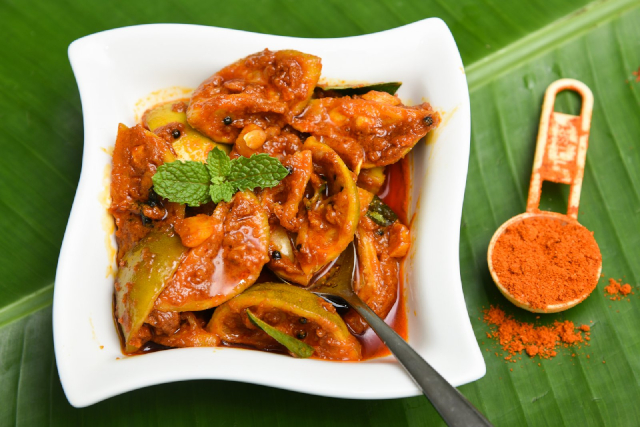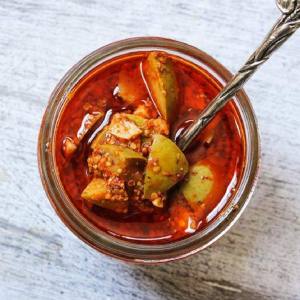Represented in Wikipedia by an article under the deceptively bland title, ‘South Asian Pickle’, Achaar is actually a condiment found in most Indian kitchens, considered an indispensable staple – just the thing to make a bowl of plain streamed rice a culinary work of art…
 Lime Achaar: A northern favourite. Mango Achaar (see photo, top of page) is
Lime Achaar: A northern favourite. Mango Achaar (see photo, top of page) is
the far more common version. Make your own to your personal taste!
My Dad’s mother was a prim and proper Victorian girl who embraced and upheld her era’s culinary traditions, including the English ‘standards’ imported from all corners of the empire upon which the sun never set. One of those was Mango Chutney. I think we’ve all tried it at one time or another. And I think we would agree it has a distinctive spicy, fruit pickle flavour. But there’s much more to the story we all should be aware of, if we’re to truly appreciate this South Asian classic. First, we must be aware that real-deal Indian Pickle is quite different from the British ‘chutney’ version.
‘Achaar’ is the word
“Achaar is a catch-all term for pickle, a popular condiment in Indian cuisine,” Chef Alice Waters explains in her Masterclass.com essay. “Pickles in the north of the country are typically made with mustard oil, while the South Indian style is made with sesame oil. Achaar adds a tangy, sweet, and salty heat, whether on its own as a side dish or paired with rice, stews, or layers of paratha. It’s the Indian answer to kimchi.”
The truth is, while Achaar is most often made with mangoes or plums, it can be made with almost any fruit that’s handy and in season. But to be absolutely authentic, it must be made with Aam ka achaar – spicy green mango. Depending on where in India you find it, it may also include carrot, lime or lemon, or even gooseberries as supporting actors.
The spice is right
The truth is, the fruit is just a base, a carrier for the classic flavours that make Achaar so special. These might include Red Chili Pepper, Asafetida, Turmeric, Cumin, Fenugreek or Sesame Seeds, Mustard Seeds and Mustard Oil, Sugar syrup and lots of Salt.
In India, most folks who cook for their families make their own Achaar, according to their own family recipes. But factory-made versions are increasingly available in the larger urban centres where many middle and upper-class folks don’t have time to do such stuff. Still, I’ll bet you a case of mangoes that city folks who’ve embraced the European work ethic still get homemade Achaar from their moms or grandmothers when they can.
Tips and techniques
First rule of Achaar: Southern Asian cooks will try pickling almost anything! You’ll be amazed at the variety of Achaars you’ll encounter from region to region. You might even want to try making your own version from fruits and spices you love!
Achaar is a cooked pickle and it takes time to ferment in the jar. Unlike most ‘western’ pickles, it is traditionally left to mature under the scalding summer sun in closed vessels. It takes two weeks or longer for the process to come to complete itself. But you can let it ferment in a cool, dark place like Dills or Mustard Pickles. It just takes longer.
You’ll also note, when you get into the nitty gritty of various Achaar recipes, that it uses lots of salt, but no vinegar. And the main liquid is the Mustard or Sesame Oil. That oil will always separate to the top of the jar. You’ll want to stir it up well to distribute the oil throughout the mixture before serving.
Commercial Achaars are generally on the spicy side and very bold. But most westerners are more interested in the flavour nuances than the heat. Making your own Achaar is a great way to get your family to embrace it. You can make it as salty, sweet, peppery or umami-y as you like, to suit your and their taste.
If you tell your family and friends that Achaar is a condiment, make sure you also tell them it’s unlike anything they’re used to: literally a world away from yellow mustard, green hamburger relish, tomato ketchup or ranch dressing. If they were cautious about trying it at first, you’ll spike their curiosity!
And, as a totaly-free bonus, cooking up a batch of your own Achaar will lend your whole house the exotic atmosphere of an authentic Indian spice market. What better way to enhance the venue for a traditional Asian supper?
A final word…
Spicy garlic is an ultra-popular variant on the savoury side of the Achaar continuum. If you like garlic and heat, make sure you try this one! It’s also a great example of a northern pickle that doesn’t necessarily rely on mangoes or other bob-citrus fruit. The more you Google ‘Achaar’, the more variations and versions you’ll encounter. Have fun!
~ Maggie J.

